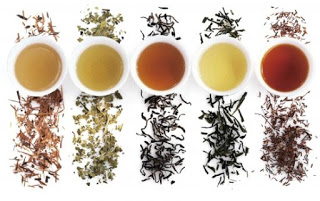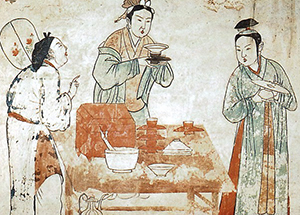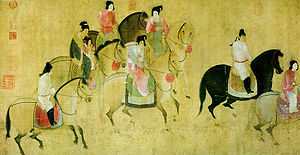History of Tea Culture in China and Japan
September 8, 2017

To the literati and officialdom of ancient China, tea represented “elegance, harmony, friendliness, and grace”. The act of tea drinking was a way in which one could “cultivate the mind and improve moral integrity” and it was admired as a drink that was pure of content and consisting of elegant qualities.
The discovery of tea goes back to the early history of China and, through time, has been developed into an important subject of various forms of art, significant social events, intense competitions, and daily activities. Poems were written about its unique qualities and paintings were created by its inspiration. Tea also became a staple for devout Buddhist monks who appreciated its close tie to nature, its medicinal value, and its ability to chase away drowsiness during long sessions of meditation.
Through trade, tea spread from Chine to Japan, as well as numerous other countries around the world. In Japan, the use of tea went through several transformations from the time of its introduction, with the tea ceremony eventually developing into a highly ritualized and religious event while in China the tea ceremony remained mainly a time for social gatherings and quiet relaxation.
For the Chinese, the tea plant has been held in high esteem for its various valuable qualities: its medicinal properties, its ability to restore wakefulness, its close tie to nature, its relative inexpensiveness, and, overall, its distinct and desirable taste. However, the appreciation for all of those qualities was not fully present at the beginning of its use; the appreciation for tea as a drink had to develop over a fairly long period of time.
 The use of tea dates back to 2737 BCE during the reign of the Chinese Emperor, Shennong, who is given credit for having been the one to discover the beverage. The legend states that, one afternoon, Shennong was taking a walk when he decided to stop and rest under a tree. A servant then presented Shennong with a cup of boiled water to drink (water was boiled during this time for hygienic reasons) when a leaf from the tree he was sitting under fell into his cup of water and began to steep. The Emperor, being a scientist, decided to taste the water when he saw that the leaf made it turn a light brown color. Enthralled with the aromatic scent and floral taste, the emperor decided that this should be a drink in China.
The use of tea dates back to 2737 BCE during the reign of the Chinese Emperor, Shennong, who is given credit for having been the one to discover the beverage. The legend states that, one afternoon, Shennong was taking a walk when he decided to stop and rest under a tree. A servant then presented Shennong with a cup of boiled water to drink (water was boiled during this time for hygienic reasons) when a leaf from the tree he was sitting under fell into his cup of water and began to steep. The Emperor, being a scientist, decided to taste the water when he saw that the leaf made it turn a light brown color. Enthralled with the aromatic scent and floral taste, the emperor decided that this should be a drink in China.
While this legend may hold several truths, it is generally believed by scholars that tea and tea-drinking underwent about four major phases before becoming the drink that most people are familiar with today. The first phase began before, and continued into, the Spring and Autumn Period (770 BCE – 476 CE). During this phase, tea leaves were mainly picked to be eaten as a source of food. The leaves were later discovered to have medicinal value that was used to aide in curing numerous ailments such as digestive issues.
The second phase took place starting in the Pre-Qin Period (before 221 BCE) and continued on into the Eastern and Western Han dynasties (207 BCE – 189 CE). Here, tea was used for the first time as a beverage when it was mixed with millet, along with other condiments according to taste preference, and was then boiled until it became a drink with a porridge-like consistency.
Come the time of the Tang Dynasty (618 – 907 CE), the third phase was beginning as the Chinese began grinding dried tea leaves into a powder and then leaving them to steep in boiling water. It was also during this dynasty, in the early 800’s, that tea made its way to Japan in this powdered form, which will be discussed further at a later point.
 When the Song Dynasty (960 – 1127) came to power, this form of tea-drinking had become the preferred method of consuming the beverage. Although powdered tea prevailed in popularity starting in the Tang Dynasty, another method was also developed that would slowly but surely gain in momentum: roasting and baking.
When the Song Dynasty (960 – 1127) came to power, this form of tea-drinking had become the preferred method of consuming the beverage. Although powdered tea prevailed in popularity starting in the Tang Dynasty, another method was also developed that would slowly but surely gain in momentum: roasting and baking.
This method pushed tea-drinking into what could be considered the fourth and final phase of tea development. The process involved picking the young and tender green tea leaves in the spring, roasting and baking them, and then “making them into whole separate tea leaves”. However, even though this method of tea-drinking existed in the Tang and Song dynasties, it was not until the Ming (1368 – 1644) and Qing (1644 – 1912) dynasties that whole leaf tea became the predominant way to drink tea in China.
Tea is an important aspect of Chinese and Japanese culture because it embodies so many important aspects of both cultures. Not only could it be seen as a physical representation of nature, but it can provide one with a moment of tranquility that can be hard to find in this busy world.
